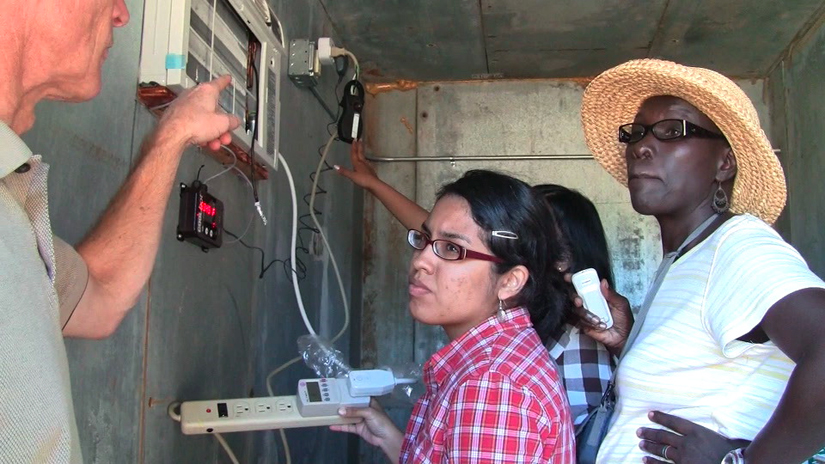
A version of this article originally appeared in the Feed the Future newsletter.
In many developing countries, more than half of all fruits and vegetables are never eaten, but are instead lost to damage or spoilage after harvest. These post-harvest losses can mean that farmers need to sell their fresh produce immediately at whatever price they can get, before they lose the crops that represent investments of labor, water, and agricultural inputs. Improving how fruits and vegetables are handled after harvest can significantly prolong freshness — and cooling is key.
“The three most important aspects of postharvest handling are: temperature, temperature, temperature,” said Michael Reid, a postharvest specialist who works with the Horticulture Innovation Lab at the University of California, Davis. “In the developing world in particular, affordable cooling technology is mostly absent.”
Cooling can be an expensive challenge — even for American farmers.
As a farmer in upstate New York, Ron Khosla knew this problem too well. His vegetable crop was spoiling too quickly, but he could not afford to buy a walk-in cooler for his small farm. So he invented a solution: a small electrical device he called a CoolBot that tricks an air conditioner into getting colder without freezing over, turning a well-insulated room into a cold room for less than it cost to buy a refrigeration unit.
“I was hoping for a cheap, DIY solution that I could maintain, but mostly I just needed to keep my leafy greens and strawberries cold,” Khosla said.
One of his farming customers suggested he sell this device to other farmers, so he started a small business called Store It Cold, LLC.

Khosla’s CoolBot invention caught the eye of postharvest researchers, including Reid. He partnered with agricultural scientists from Uganda, Honduras, and India to test the CoolBot in their climates, insulating each of the cold rooms with different local materials.
Since that first project, the Horticulture Innovation Lab has tested CoolBots for farmer cold storage in Tanzania, Zambia, Uganda, Thailand, Cambodia, Bangladesh, India and Honduras. Reid has contacted Khosla, the farmer-inventor, for troubleshooting, sharing challenges and results from new locations. In places without reliable electricity, Reid has tested options for solar power.
Another Horticulture Innovation Lab partner who has worked with the CoolBot is Jane Ambuko of the University of Nairobi. She received a grant to pilot this technology among horticultural farmers for the Kenya Feed the Future Innovation Engine.
“I see the CoolBot making a whole lot of difference,” Ambuko said during a TEDxNairobi speech. “But for it to make that desired difference we have to make it cost-effective and affordable for the smallholder farmers.”
In many places, the most expensive part of a CoolBot-equipped cold room is the structure for the insulated room, but both Reid and Khosla expect foam building materials to become a more widely available, affordable solution.
Khosla’s small business has been growing — selling to not only farmers, but also florists, micro-brewers, and other artisanal food businesses. Now with six employees, the company has sold more than 27,500 CoolBots in 51 countries.
“I’m thrilled and so grateful to be a part of helping lots of people. Working with USAID has gotten us known in other countries, and I’m looking forward to the day when we have enough in-roads in India and Africa where we can work directly with farmers there,” Khosla said. “People didn’t believe the CoolBots worked at first. But now we get the most amazing letters from people whose business has doubled or quadrupled. Good postharvest care makes such a difference. Once they try it, then they see.”
Update: After this article was written, a new partnership with Store It Cold, LLC, was announced by the Feed the Future Partnering for Innovation program, for a two-year project that focuses on promoting the CoolBot among exporters and agricultural associations in Honduras as a low-cost alternative to refrigeration.
Related links for more information:
- Store It Cold, LLC website
- Coolbot technology– Post harvest storage solutions video of talk by Jane Ambuko at TEDxNairobi
- Cutting down on post harvest losses, Jane Ambuko on NTV Food Friday segment
- Photos of the CoolBot in action on Flickr
- Demonstrating low-cost cooling technology in Honduras, India and Uganda, the Horticulture Innovation Lab project led by Michael Reid
- CoolBot fact sheet: CoolBot provides inexpensive, effective cooling
- Success story fact sheet: How one farmer’s invention is reducing food waste
- More CoolBot resources
